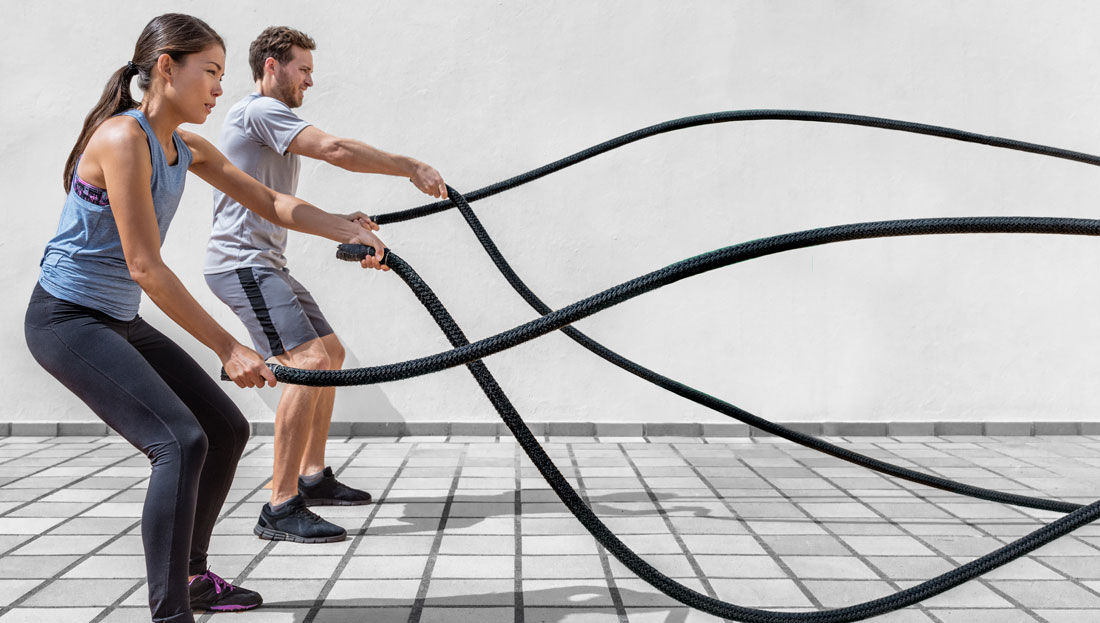
By Kacey Iwen, MS, John P. Porcari, PhD, Susan Bramwell, MS, Scott Doberstein, MS, Blaine Arney, MS, and Carl, Foster, PhD, with Daniel J. Green
ACE recently reported on research on muscle activation during battle rope exercises. In that study, the researchers concluded that battle rope exercises overload the muscles enough to drive improvements in muscular strength and are therefore an effective, fun and challenging addition to any client’s full-body training regimen.
Here, ACE takes a second look at battle ropes, shifting the focus from muscular training to cardiorespiratory training. Can your clients improve their cardiorespiratory endurance with interval training using battle ropes? To find out, ACE asked John P. Porcari, PhD, and his research team in the Department of Exercise and Sport Science at the University of Wisconsin–La Crosse to evaluate the cardiorespiratory and metabolic responses of a battle rope interval workout.
The purpose of this study was to determine the exercise intensity and energy expenditure of a battle rope interval exercise session in healthy, active individuals. According to industry guidelines, exercise intensity needs to be 46 to 90% of maximal oxygen consumption (VO2max) and 64 to 95% of maximal heart rate (MHR) in order to improve cardiorespiratory fitness [American College of Sports Medicine (ACSM), 2018]. When it comes to energy expenditure, it is recommended that individuals expend 1,200 to 2,000 kcal per week (240 to 400 kcal per exercise session) in order to have a positive effect on body composition (Donnelly et al., 2009).
The Study
Researchers recruited 14 male participants between the ages of 18 and 23 years old. All were considered apparently healthy and active (i.e., exercising at least three times a week for the past six months) and did not have any cardiovascular or orthopedic contraindications. In addition, all participants had some experience with battle rope exercise.
Prior to beginning the study, all participants completed a maximal exercise test on the treadmill to determine MHR and VO2max (Table 1).
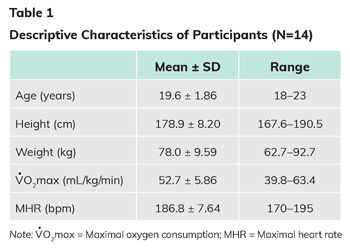
The study itself consisted of a single battle rope session, which began and ended with the participants warming up and cooling down on a Schwinn Airdyne dual-arm fan bike for five minutes.
Most workouts using battle ropes (including the one used in this research) are a form of high-intensity interval training (HIIT). The intensity can be adjusted not only by the speed and amplitude of the wave motion produced by the exerciser, but also by rope length and diameter (Stanforth et al., 2015).
For this study, the researchers used a rope that was 50-feet long and had a diameter of 1.5 inches. The rope was anchored at its midpoint. The workout consisted of the seven exercises listed in Table 2. The participants practiced all of the exercises prior to being tested.

For each exercise, the participant started by grasping one end of the rope in each hand with palms facing each other, feet shoulder-width apart, and the knees slightly bent. Each exercise was performed twice. Total workout time was 14 minutes, with intervals of 15 seconds of exercise followed by 45 seconds of rest. During the rest periods, participants were asked to sway back and forth as a form of active recovery.
Exercises were presented in a random sequence for each participant. Additionally, each participant was asked to complete the workout at a self-selected intensity but was encouraged to exercise as fast and hard as possible.
Heart rate (HR) and oxygen consumption (VO2) were recorded throughout the workout. Rating of perceived exertion (RPE) was assessed after every exercise using the 6 to 20 RPE scale. In addition, blood lactate was measured at rest and five minutes after the battle rope workout was completed.
The Results
Heart Rate
HR responses to the seven different battle exercises are presented in Table 3. Overall, participants exercised at an average HR of 148 ± 14.9 bpm and 79 ± 8.4% of MHR. The average HR and %MHR for “double-arm power slams” and “outward arm circles” were significantly greater than “double-arm wave” and “in and out waves.” The average peak HR observed for the battle rope exercise session was 162 ± 11.6 bpm, with an average peak %MHR of 87 ± 6.0%.

The HR response of a single participant during the battle rope workout is presented in Figure 1. Because each participant completed the battle rope exercises in a different order, a composite graph could not be generated. The boxed region represents the current guidelines for improving cardiorespiratory endurance for this participant based on his individual MHR (ACSM, 2018). The dotted line represents the delineation between moderate intensity (64 to 76% of MHR) and vigorous intensity (77 to 95% of MHR). As can be seen in Figure 1, there was a tendency for HR to drift upward over the course of the battle rope workout.
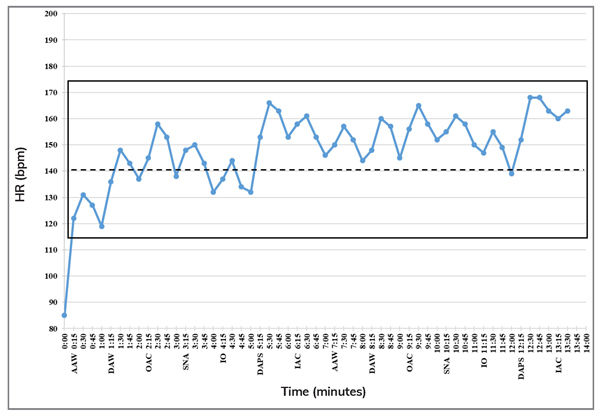
Figure 1
Heart-rate Response of a Single Participant During the Battle Rope Workout
Note: AAW = Alternating arm wave; DAW = Double-arm wave; OAC = Outward arm circles; SNA = Snake waves; IO = In and out waves; DAPS = Double-arm power slams; IAC = Inward arm circles
Oxygen Consumption
Oxygen consumption responses to the seven battle rope exercises are presented in Table 4. Overall, participants exercised at an average VO2 of 26.9 ± 5.27 mL/kg/min and 51 ± 9.5% of VO2max. The average VO2 and %VO2max for “double-arm power slams” was significantly greater than all other exercises. The average peak VO2 for the battle rope exercise session was 32.8 ± 5.38 mL/kg/min, with an average peak %VO2max of 63 ± 7.5%.
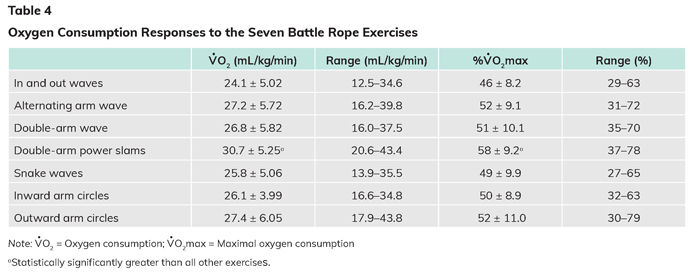
The VO2 response during the battle rope workout of the same participant represented in Figure 1 is presented in Figure 2. The boxed region represents the current guidelines for improving cardiorespiratory endurance for this participant based on %VO2max (ACSM, 2018). The dotted line represents the delineation between moderate intensity (46 to 63% of VO2max) and vigorous intensity (64 to 90% of VO2max).
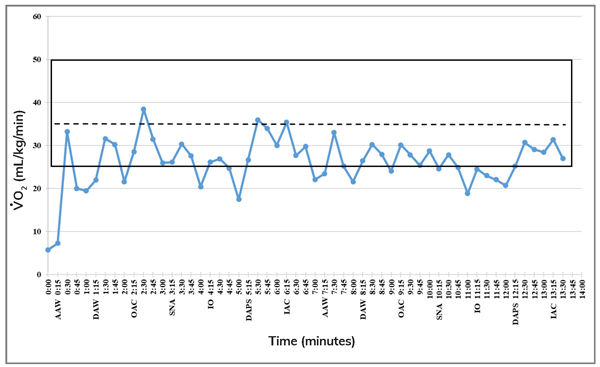
Figure 2
VO2max Response of a Single Participant During the Battle Rope Workout
Note: AAW = Alternating arm wave; DAW = Double-arm wave; OAC = Outward arm circles; SNA = Snake waves; IO = In and out waves; DAPS = Double-arm power slams; IAC = Inward arm circles
Rating of Perceived Exertion
When it came to RPE, there were no statistically significant differences in average RPE among the seven battle ropes exercises. The average peak RPE for the session was 16.3 ± 2.01, which indicates an intensity of “somewhat hard” to “very hard.” Like HR, RPE drifted upward over the course of the workout.
Blood Lactate
Blood lactate measurements taken at rest and at the completion of the battle rope workout are presented in Figure 3. Resting and post-workout blood lactates were 2.9 ± 1.36 mmol and 11.8 ± 4.24 mmol, respectively. The main significance of the high post-exercise blood lactate values is that they indicate that participants were working at a vigorous anaerobic intensity.
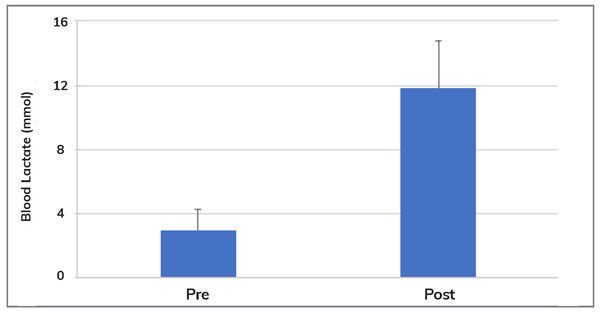
Figure 3
Blood Lactate Responses at Rest and After the Battle Rope Workout
Energy Expenditure
Energy expenditure during the battle rope workout is presented in Table 5. Aerobic energy expenditure was calculated from the VO2 data assuming a constant of 5 kcal per liter of O2 consumed. Anaerobic energy expenditure was determined from the difference between post-workout lactate and resting lactate values, multiplied by body weight, then by 3.3 mL of O2 (di Prampero and Ferretti, 1999). According to lead researcher Dr. Porcari, the measurement of blood lactate and calculation of anaerobic energy expenditure allows the researchers to more accurately measure energy expenditure during vigorous exercise.
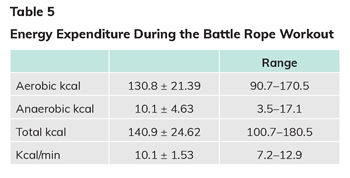
The Bottom Line
In this study, participants worked at an average HR of 148 ± 14.9 bpm and 79% of MHR during the battle rope workout, which falls into the vigorous intensity range. In terms of VO2, participants exercised at an average VO2 of 26.9 ± 5.27 mL/kg/min and 51 ± 9.5% of VO2max. The exercise with the highest average HR response and the highest average VO2 response was the “double-arm power slams.”
The average energy expenditure in this study was 10.1 ± 1.53 kcal/min, meaning that the participants expended 140.9 ± 24.62 calories during the 14-minute session. While this falls below the 240 to 400 calories recommended burned per session in order to have a positive effect on body composition (Donnelly et al., 2009), this was due solely to the short duration of the workout.
To summarize, a battle rope interval exercise session meets guidelines for improving cardiorespiratory endurance and would be classified as a vigorous-intensity activity (ACSM, 2018). Based on the HR and VO2 responses, “double-arm power slams” were the most intense exercise.
According to Dr. Porcari, what makes battle ropes such an intriguing option is that the workouts are “infinitely customizable.” By modifying the thickness or length of the rope, the duration of the intervals and rest periods, or the muscle groups used, you can decrease or increase the intensity of a battle rope workout as needed to create personalized programming for your clients.
Finally, Dr. Porcari suggests we look at the results of this study in concert with the ACE-sponsored research on muscle activation during battle rope workouts, which used these same seven exercises to determine whether the workout is adequate to cause gains in muscular strength. That study concluded that battle ropes exercises offer a full-body training regimen that is challenging enough to elicit strength gains.
It turns out that battle ropes provide a workout that is intense enough to improve both muscular strength and cardiorespiratory endurance, making them a worthwhile addition to many of your clients’ workout programs.
This research study was first published in the peer-reviewed International Journal of Research in Exercise Physiology.
References
American College of Sports Medicine (2018). ACSM’s Guidelines for Exercise Testing and Prescription (10th ed.). Philadelphia: Wolters Kluwer Health.
di Prampero, P.E. & Ferretti, G. (1999). The energetics of anaerobic muscle metabolism: A reappraisal of older and recent concepts. Respiration Physiology, 118, 2–3, 103–115.
Donnelly, J. et al. (2009). Appropriate physical activity intervention strategies for weight loss and prevention of weight regain for adults. Medicine & Science in Sports & Exercise, 41, 459–471.
Stanforth, D. et al. (2015). Training toys… bells, ropes, and balls – oh my! ACSM’s Health & Fitness Journal, 19, 4, 5–11.





 by
by 











